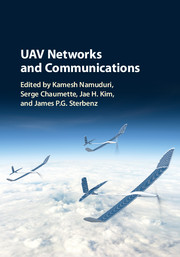Book contents
- Frontmatter
- Dedication
- Contents
- Preface
- Contributors
- 1 Introduction to UAV Systems
- 2 Air-to-Ground and Air-to-Air Data Link Communication
- 3 Aerial Wi-Fi Networks
- 4 Disruption-Tolerant Airborne Networks and Protocols
- 5 UAV Systems and Networks: Emulation and Field Demonstration
- 6 Integrating UAS into the NAS – Regulatory, Technical, and Research Challenges
- 7 Safety, Security, and Privacy Aspects in UAV Networks
- 8 Collaboration Between Autonomous Drones and Swarming
- 9 Real-World Applications
- References
- Index
3 - Aerial Wi-Fi Networks
Published online by Cambridge University Press: 17 November 2017
- Frontmatter
- Dedication
- Contents
- Preface
- Contributors
- 1 Introduction to UAV Systems
- 2 Air-to-Ground and Air-to-Air Data Link Communication
- 3 Aerial Wi-Fi Networks
- 4 Disruption-Tolerant Airborne Networks and Protocols
- 5 UAV Systems and Networks: Emulation and Field Demonstration
- 6 Integrating UAS into the NAS – Regulatory, Technical, and Research Challenges
- 7 Safety, Security, and Privacy Aspects in UAV Networks
- 8 Collaboration Between Autonomous Drones and Swarming
- 9 Real-World Applications
- References
- Index
Summary
Introduction
Autonomous unmanned aerial vehicles (UAVs) are considered with increasing interest in a diverse set of civil and commercial applications, such as environmental and natural disaster monitoring, border surveillance, emergency assistance, search and rescue missions, delivery of goods, and construction [208, 132, 362, 265, 434, 110, 280, 163]. Use of single or multiple UAVs as communication relays or aerial base stations for network provisioning in emergency situations and for public safety communications has been of particular interest due to UAVs fast deployment and large coverage capabilities [331, 193, 206, 429]. The deployed aerial platform size and the number of necessary platforms are key factors in determining the on-board communication system in addition to the coverage and capacity requirements [73].
Small-scale multi-rotors are of particular interest in practice due to their ease of deployment, low acquisition and maintenance costs, high maneuverability, and ability to hover. Research and development of small-scale UAVs focused initially on control issues, such as flight stability, maneuverability, and robustness, followed by designing autonomous vehicles capable of waypoint flights with minimal user intervention. Considering the limited flight time and payload capacity of these vehicles and the area sizes the aforementioned applications might span, the interest is shifting more and more toward collaborative multiple UAV systems for efficient and successful missions. The number of UAVs might be from tens to hundreds traveling over tens of meters to kilometers for different applications (see Figure 3.1 for an illustration).
Wireless communication is an essential factor not only for network provisioning with UAVs but also for successful deployment of systems consisting of multiple small-scale UAVs. It is highly likely that high-performance links and connectivity in three-dimensional space will be required for several applications (e.g., monitoring certain areas) with data delivery meeting a certain quality of service demands [35].The question arises as to which wireless technology should be employed for aerial networks that consist of air-to-ground and air-to-air links, and data needs to be delivered regardless of significant height and orientation differences. Taking into account the quality of service to be satisfied over diverse links and the high node mobility, it is not yet clear as to whether networking protocols developed for ground networks are readily deployable on UAV networks.
- Type
- Chapter
- Information
- UAV Networks and Communications , pp. 45 - 57Publisher: Cambridge University PressPrint publication year: 2017



